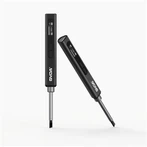How do you self-excite a series-type switching power supply by itself
Self-excited switching power supply according to the input and output connection can be divided into series (step-down non-isolated), parallel (step-up non-isolated) and transformer-coupled (isolated). In the transformer-coupled self-excited switching power supply, according to the connection of the switching tube can be divided into a single tube, push-pull and bridge type. Since the self-excited parallel type belongs to the boost type, practical applications are rare.
General AC and DC conversion of self-excited series-type and transformer-coupled switching power supply applications.
Self-excited series type switching power supply principle of operation
Self-excited series-type switching power supply is an early use of a switching power supply, due to the switching tube, energy storage inductance and the load in series, the output voltage is lower than the input voltage, also known as step-down non-transformer-coupled switching power supply.
Self-excited series-coupled switching power supply structure schematic diagram. C1, Cz are the input voltage U1 and output voltage U2 filter capacitors; switching tube VT with A switching symbol analogue replacement, L for the energy storage inductor, VD for the continuity diode, C3 series connection of R1 is generated switching transistor base b, to provide high-frequency conduction or cutoff supply path.
This is the simplest form of series-type switching power supply, understand the principle of operation, can easily look at the other included circuits also contain sampling circuit, voltage reference, comparison amplifier and pulse width amplifier. voltage reference, comparative amplification and pulse width modulation circuitry. Picture of a simple self-excited self-excited switching circuit, it is the use of the circuit of the VT switching tube pulse transformer L constitutes a self-excited oscillator to complete the power supply start-up work, so that the power supply has a DC voltage output.
Here I take 220V AC as the input to the power supply input U1.
220V AC through the bridge rectifier or single-phase half-wave rectifier, bridge rectifier efficiency of 0.9, half-wave rectifier efficiency of 0.45, rectified through the C1 filter output of about 280 VDC. After rectification, the DC voltage of about 280 V is filtered by C1 and output all the way through the primary winding of L to the collector of the switching tube VT; the other way through the start capacitor C3 and series start current limiting resistor R1 to the base of the switching tube to provide bias current to VT. The other way through the start capacitor C3 and series start current limiting resistor R1 to provide bias current to the base of VT switching tube, so that the VT conducts very quickly, the primary winding in the L generates an induced voltage, through the three head coils of the L, coupled to the positive feedback winding, and put the The induced voltage is fed back to the base of VT, making VT enter into saturation conduction state.
When VT saturation, because the collector current remains unchanged, the voltage on the primary winding disappears, VT out of saturation, the collector current decreases, the feedback winding produces a reverse voltage, so that VT Reverse bias cut-off. So repeated many times, the cut-off formation of self-excited oscillation. Connected to the L primary winding of the secondary generation of high-frequency pulse voltage directly from the switch emitter e Output to other loads, but in order to make the output DC voltage in the ripple coefficient is small, in the circuit and add an electrolytic capacitor Cz again filter. The output voltage is the load resistor (Cz) of the switch. DC voltage.






